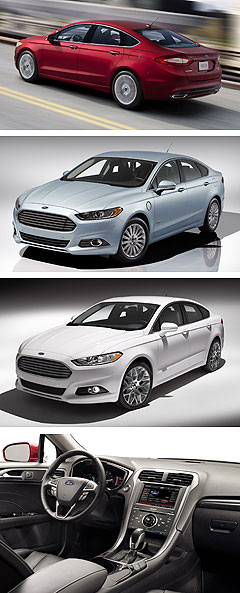Future models - Ford - MondeoDetroit show: Ford’s next Mondeo unmaskedTop shelf: Ford describes its redesigned Fusion as a ‘top-drawer visual experience’ for the mainstream mid-size sedan buyer. All-new Ford mid-sizer emerges in the US but Australia must wait until 20139 Jan 2012 By TERRY MARTIN FORD has taken the covers from its redesigned Fusion at this week’s Detroit auto show, more than a year before the sleek and sculptural medium-sized car will be launched in Australia as the fourth-generation Mondeo. Although the vehicle enters production in the US and Mexico later this year for the North and South American markets, the Blue Oval has confirmed that the new Mondeo will not be introduced in Europe and Asia – including Australia – until 2013. The Fusion is a fresh example of Ford’s more emotional design language that differentiates the brand from the more conservative Toyota Camry and Honda Accord, and which also points the way to the styling of the forthcoming next-generation Taurus and Falcon large cars. The latter two models are also talking points in Motown this week as federal manufacturing minister Kim Carr enters another round of talks with Ford Motor Co senior management in an effort to shore up the company’s manufacturing future in Australia. The new Fusion is billed as the first sedan to offer petrol, hybrid and plug-in hybrid powertrains and also carries a range of “must-have technologies”, including a lane-keeping system, adaptive cruise control, active park assist, blind-spot warning and ‘MyFord Touch’ internet capability. “Our vision for Fusion was clear – deliver the very best of what ‘One Ford’ stands for,” said Ford’s group vice-president of global product development, Derrick Kuzak.  “We brought our global teams together around a blank slate with the charge to develop a mid-size car with groundbreaking design and jaw-dropping fuel economy – one that featured technologies to help make our customers safer and better drivers. “This car is the result.” While the diesel engine line-up for Mondeo will be revealed closer to its European launch in the first quarter of next year, Ford claims best-in-class fuel economy for the US-spec Fusion in the petrol, hybrid and plug-in hybrid sub-segments. The straight petrol line-up comprises 133kW/233Nm 1.6-litre and 177kW/339Nm 2.0-litre EcoBoost direct-injection turbocharged four-cylinder engines and a naturally aspirated 126kW/230Nm 2.5-litre four, with the 1.6 engine delivering claimed 26/37mpg city/highway fuel consumption (equivalent to 9.0/6.4L/100km). Although fitted standard with a six-speed manual, the 1.6 will also offer a six-speed automatic paired with an engine idle-stop system – the first such combination for Ford. The 2.0-litre is billed as the performance option, mating with a six-speed paddle-shift automatic transmission and to be available with 19-inch wheels and tyres and all-wheel drive. The Fusion Hybrid downsizes to a new 2.0-litre Atkinson-cycle four-cylinder petrol engine – reduced from 2.5 litres displacement – and switches battery technology from nickel-metal hydride to lithium-ion. Ford claims the hybrid “maintains performance standards” – combined output is a projected 137kW and 176Nm – and can achieve city/highway mileage of 47/44mpg (5.0/5.3L/100km) to outperform key petrol-electric competitors such as the Toyota Camry Hybrid and Hyundai Sonata Hybrid. The lighter and more powerful battery pack is reflected in the city cycle result, while maximum speed under electric-only power also rises from 47mph (75km/h) to 62mph (100km/h). The ‘Energi’ plug-in hybrid version is expected to deliver more than 100mpg-e – a mile per gallon equivalency metric for EVs used in the US – and outperform the Chevrolet Volt and Toyota Prius plug-in. Indeed, Ford believes the Fusion Energi will be the most fuel efficient mid-size car in the world. Specifications show the new model rests on the same 2850mm wheelbase as current Mondeo and has a similar footprint, measuring 4870mm long, 2120mm wide and 1476mm wide. Front/rear wheel tracks are 1592mm and 1584mm respectively, while kerb weight for conventional-engine models starts at 1507kg (1.6 EcoBoost manual). Ford says the new Fusion is roomier – owing to the instrument panel positioned closer to the windscreen and thinner seat frames – and that body strength has increased 10 per cent with the use of more high-strength steels. First-row knee airbags and adaptive front airbags have been developed, while dynamic performance improves with an “all-new premium-level” multi-link rear suspension that Ford claims is “comparable to Audi and BMW configurations”. The front suspension continues as a MacPherson strut design, while the steering moves from a conventional hydraulic system to a “specially tuned” electric power-assisted set-up with 2.7 turns lock to lock. Refinement levels are said to have increased with the use of new undercarriage shields and weight-saving sound-absorption material. A full-perimeter bonnet seal is also used to minimise engine noise, while hybrid and plug-in hybrid models are equipped with ‘active noise control’ – a feature that uses the stereo to “mitigate extraneous road noise while enhancing powertrain sounds”. Drawing from the Evos concept unveiled at last year’s Frankfurt motor show, the Fusion’s exterior design aims to appeal to mainstream sedan buyers by “adding some emotional appeal to an already sensible choice”. The interior is described as a sporty, driver-oriented environment that “delivers on the promise of high visual quality, with improved materials, elevated levels of craftsmanship and attention to detail”. An example given is a spring-loaded cover for the boot latch hardware that comes into play whenever the bootlid is opened. The Fusion will be offered in North America in S, SE and range-topping Titanium model grades.  Read more9th of January 2012  New Mondeo to preview future big FordsFord design chief reveals simplified ‘premium look’ will point to Falcon replacementMondeo pricing
Motor industry news |
Click to shareFord modelsResearch Ford Mondeo pricing
Motor industry news |
















Facebook Twitter Instagram